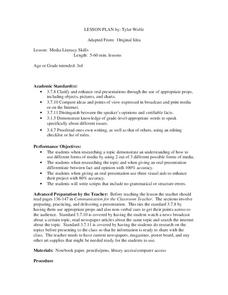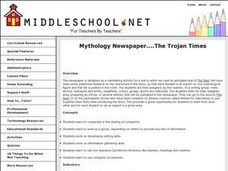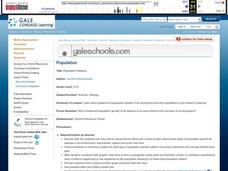Curated OER
Nonviolent Conflict Resolutions with Cesar Chavez
Third graders investigate nonviolent conflict resolution strategies. In this interpersonal communication lesson, 3rd graders explore conflict resolution. Students construct a newspaper/magazine article detailing nonviolent conflict...
Curated OER
If Hornets Could Talk
Fifth graders create a school newspaper. In this journalism lesson plan students write articles for a school newspaper. They also create an informational website. the projects are both on-going.
Curated OER
ESL News Press
Students assume the roles of editors and news reporters and develop and create a school newspaper. Working in groups they brainstorm article topics for different sections of the paper. They conduct research about current events,...
Curated OER
Thoughts to the President
Students write a persuassive paragraph to the President stating their opinion on a topic. To do this, they start the message with a topic sentence such as "War is _____." The blank should contain a word or phrase expressing the student's...
Curated OER
Science in the News
Young scholars explore science in the news through articles, magazines, and internet news sites. They select articles, read them and summarize them to identify the audience that would care about their topics. As they present their...
Curated OER
Building on the Past
Students consider how the scientific advances of the past have contributed to the science topics reported on today in the Science Times section. After reading a current science article, they compare and contrast the way science was...
Curated OER
Read All About It! Looking at Newspapers.
In this newspaper activity, students read about emotive language, then choose headlines that are most likely to excite a reader, re-write headlines, replacing words with more emotive words, and read a short article and answer 3 related...
Curated OER
Change Over Time
Learners write a personal narrative that is designed to help them reflect on the nature and meaning of change in their lives.
Curated OER
Listening for Leschi: Voices from the Past
Learners interview a family other than their own to learn about oral history. In this oral history lesson plan, students also create a newspaper article about Leschi and pretend they interviewed him back in the past.
Curated OER
Facts and Opinions
In this fact and opinion learning exercise, learners decide if statements are facts or opinions, write facts and opinions, and more. Students complete 6 activities.
Curated OER
Details
Third graders write journals, newspapers, and letters with details to enhance their main points. In this details lesson plan, 3rd graders retell an incident with details, create newspaper articles with details, and write letters with...
Curated OER
Caught Between Worlds: Frontier Life as Reflected in Captivity Narratives
Young scholars analyze captivity narratives written between the 1600's and 1800's. In this narrative lesson, students think critically about the interaction between Native peoples and the settlers to understand the cultural beliefs held...
Curated OER
Understanding Persuasive Writing
High schoolers give examples of how the media glamorize violence and desensitize viewers to the horrors of real acts of violence. They identify factors in addition to the media that contribute to the problem of violence in society.
Curated OER
In the News
Fourth graders will use AlphaSmarts/Neos to create a one page newspaper in Word which features an early explorer. This lesson can be done entirely in the classroom. The students will perform research about the explorer prior to the...
Curated OER
Buckling Up May Not Help Bus Safety
Students discuss the issue of putting seat belts in all school buses. Using the internet, they research how other districts are solving this problem. They interview school administrators about the pros and cons of putting seat belts in...
Curated OER
Vandalism leads to locked bathrooms
Pupils research bathroom vandalism in other schools like Freedom High after reading an article about Freedom High and their situation. Students then decide if their school has a similar problem and interview administrators and janitors...
Curated OER
Media Literacy Skills
You're on camera! Third graders find a news story and research it to get more information. Everyone uses their found information to write a script and create their own news broadcast!
Curated OER
Weapons in school: Protection or danger?
Students write an editorial (staff opinion) or commentary (writer's opinion) if they/he or she believe the school rules are either too strict or too lenient when addressing weapons possession. Students research past situations in their...
Curated OER
Welcome to My Community!
A "Welcome to Our Community" brochure culminates research into the people and places of interest in your community. Class members work alone or in pairs to gather information, illustrate, and write about various topics. Materials are...
Curated OER
Mythology Newspaper....The Trojan Times
Students are assigned to a writing group: news stories, obituaries and births, classifieds, comics, gossip, sports and editorials. The newspaper covers mythological figures in history. This is a very clever, meaningful lesson in mythology!
Curated OER
Creative Writing - I AM A FISH
Ninth graders write a letter to the editor about the impact of people on marine life from the point of view of a fish.
Curated OER
Writing to Focus Reading and to Imagine Researching
Students examine several elements that would cue them into a newspaper article about community change without reading the main copy text. They discuss the details and write notes about the article. They first skim and then thoroughly...
Education World
Human Nature- Good or Evil?
Students explore the philosophical nature of good vs. evil. In this literacy/philosophy instructional activity, students read and discuss media articles that illustrate human nature as inherently "good" or "evil." Students practice...
Curated OER
Population Patterns
Students study patterns of population growth in an ecosystem and why populations must remain in balance. They interpret basic population graphs and suggest scenarios about different population growth patterns in an ecosystem.

























